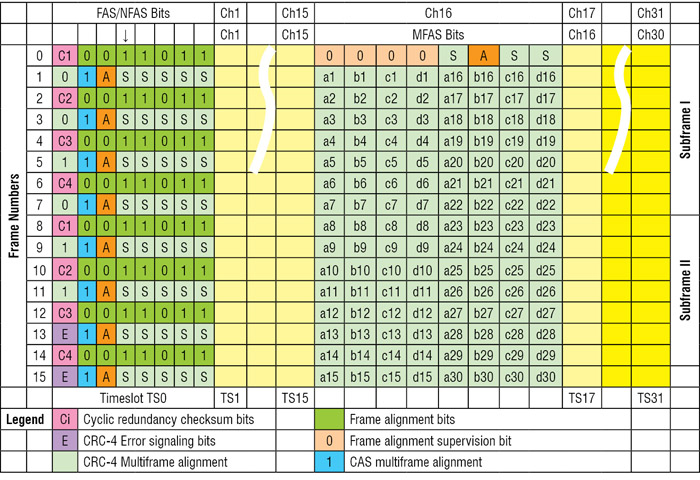General structure of PDH signals
The PDH signal is a serial signal stream with a frame structure formed by bit-interleaving the various signals carried within its structure. A general frame structure for a 2.048Mbps bit steam is shown in Fig. 3. Each frame consists of 30 channels in channel-associated signalling (CAS) scheme or 31 channels in common-channel signalling (CCS) scheme. Sampling rate of each channel is 8000 samples/s (frame duration 125 microseconds) and there are 8 bits/sample. Thus, the basic speed of each channel is 8000 samples/s × 8 bits/sample = 64 kbps. In total, there are 32 time slots in each frame (designated as TS0, TS1, …. , TS31) resulting in 32 × 64kbps = 2.048Mbps speed.

In CCS scheme, TS0 and TS16 time slots are used for synchronisation, bit-error detection, alarm indication, frame alignment, etc. Cyclic redundancy check (CRC-4) bits allow the detection of errors. In TS0 time slot, frame alignment supervision (FAS) bits allow targeting of synchronisation to find the beginning of the frame. FAS bits are only transmitted on odd frames. Non-frame alignment supervision (NFAS) is used to manage alarms and errors, such as loss of signal (LOS) indication in the event of link failure or frame loss. NFAS uses a bit equal to ‘1’ to avoid coincidences. In TS16, bit A is used for remote alarm indication for such instances as a power fault, loss of incoming signal, or loss of multi frame alignment. Bit S is used for maintenance or performance monitoring. Multi frame alignment signal (MFAS) is used to synchronise the channel-associated signalling.
Difficulties with PDH
Traditionally, PDH system is plesiochronous, which means the network elements work more or less in time-synchronised manner, not in exact sync. Slight differences in timing signals mean that justification or stuffing is necessary when forming the multiplexed signals. Inserting or dropping an individual 64kbit/s channel to or from a higher digital hierarchy requires a considerable amount of complex multiplexer/de-multiplexer equipment.
One of the major hurdles with PDH system is adoption of different standards around the world. Various geographies of the world use different hierarchies, which lead to problems of international interworking. For example, between those countries using 1.544Mbit/s systems (USA and Japan) and those using the 2.048Mbit/s system (Europe), specialised interface equipment is required to interwork the two hierarchies.
To recover a 64kbit/s channel from a 140Mbit/s PDH signal, it is necessary to de-multiplex the signal all the way down to the 2Mbit/s level before the location of the 64kbit/s channel can be identified. PDH requires ‘steps’ (140-34, 34-8, 8-2 de-multiplex; 2-8, 8-34, 34-140 multiplex) to drop out or add an individual speech or data channel (Fig. 1).
Channel cross-connection is also an issue with PDH. In this system, identification of individual channels in a higher-order bit stream is not possible. Most PDH network equipment is proprietary. Vendors use their own line coding, optical interfaces, etc. Moreover, PDH systems lack in network management and monitoring capabilities too. In most parts of the world, there is no standardised definition of PDH bit rates greater than 140Mbit/s. Besides, each multiplexing section has to add overhead bits for justification, which is again not an efficient use of the available transmission bandwidth. PDH network architecture does not allow ring structure and works in point-to-point topology.
Conclusion
A PDH transport system provides the technical means to transfer large quantities of data between two network nodes. But it is very difficult to interoperate different PDH networks as it is a specific vendor proprietary based technology that lacks in global standardisation. Different parts of the world use different hierarchies for multiplexing and de-multiplexing. Moreover, PDH does not allow direct multiplexing, which means individual tributary signals cannot be inserted or removed into the PDH multiplexed signal without intermediate multiplexing and de-multiplexing steps. Supervision and maintenance functions are limited. This makes PDH an inefficient signal transport technology.
The author, working with BSNL, holds a PhD degree from IIT (BHU), Varanasi. He holds senior research fellowship of UGC at Centre of Advanced Study, Department of Electronics Engineering, IT-BHU in Varanasi. His current research interests include wired and wireless technologies for high-speed Internet access







